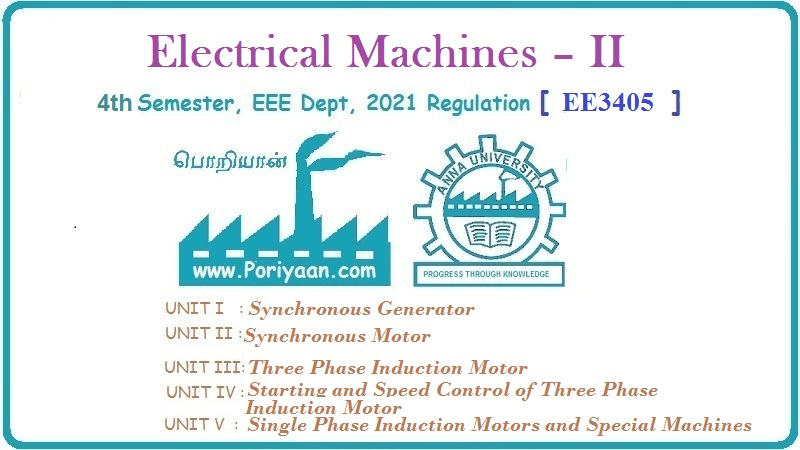Electrical Machines II: UNIT II: Synchronous Motor
University Questions with Answers (Long Answered Questions)
Synchronous Motor | Electrical Machines
Engineering Electrical Machines - II : UNIT II : Synchronous Motor : Anna University Questions with Answers (Long Answered Questions)
University Questions with Answers (Long Answered Questions)
(Regulation
2008)
May-11
Q.1
Explain 'V' and 'inverted 'V' curves of a synchronous motor. (Section 4.11) [8]
Q.
2 Draw and explain the phasor diagram of a cylindrical rotor synchronous motor
operating at different power factors. (Section 4.12) [8]
Q.
3 What is hunting ? State its causes. How it can be minimized ? Explain the use
of damper winding in synchronous motor. (Section 4.17) [8]
Q.
4 Explain how synchronous motor can be operated as a synchronous condensers.
Draw a phasor diagram. (Section 4.19) [12]
Dec.-ll
Q.
5 Explain the operation of synchronous motor at constant load variable
excitation. (Section 4.10) [8]
Q.
6 Explain 'V' and 'inverted ’V' curves of a synchronous motor. (Section 4.11) [8]
May-12
Q.
7 Why synchronous motors are not self starting ? Explain in detail. (Section
4.5) [8]
Q.
8 Explain the operation of synchronous motor at constant load variable
excitation. (Section 4.10) [8]
Q.
9 Derive an expression for the maximum torque developed per phase of a
synchronous motor. (Section 4.14) [8]
Q.10
Explain how synchronous motor can be operated as a synchronous condensers. Draw
a phasor diagram. (Section 4.19) [12]
Dec.-12
Q.
11 Discuss the various methods of starting synchronous motor. (Section 4.7) [16]
Q.
12 Describe in detail about the effect of load change on load angle and power
factor of a three phase synchronous motor operating on infinite bus bar and
constant excitation. (Section 4.8) [10]
Q.
13 Discuss in detail how V curves are
obtained for a synchronous motor. (Section 4.11) [8]
May-13
Q.
14 Explain the effect of variable load
with constant excitation on synchronous motor. (Section 4.8) [6]
Q.
15 Explain the operation of synchronous
motor at constant load variable excitation. (Section 4.10) [8]
Q.16
Derive an expression for power delivered by a synchronous motor in terms of a load
angle. (Section 4.14) [8]
Q.
17 Derive the condition for maximum power
and the value of maximum power for synchronous motor. (Section 4.14) [6]
Dec.-13
Q.
18 Explain 'V' and 'inverted 'V' curves of
a synchronous motor. (Section 4.11 [8]
Q.
19 Draw and explain the phasor diagram of
a cylindrical rotor synchronous motor operating at different power factors.
(Section 4.12) [8]
May-14
Q.
20 Explain the operation of synchronous
motor at constant load variable excitation. (Section 4.10) [8]
Dec.-14
Q.
21 Discuss the various methods of starting
synchronous motor. (Section 4.7) [16]
Q.
22 Explain the constant excitation circles for synchronous motor. (Section 4.8,
[5]
Q.
23 Explain 'V' and 'inverted 'V' curves of a synchronous motor. (Section 4.11, [8]
Q.
24 Explain constant power circle for
synchronous motor. (Section 4.16) [5]
(Regulation
2013)
Dec.-15
Q.
25 Draw and explain the phasor diagram of
a synchronous motor operating at lagging and leading power factor. (Section
4.12, [8]
Q.
26 Explain V and inverted V curves applied
to synchronous motor. (Section 4.11) [8]
Q.
27 Derive the expression for power
delivered by a synchronous motor in terms of load angle (a). (Section 4.14) [8]
May-16
Q.
28 Explain in detail V and inverted V curves of a synchronous motor. (Refer
sections 4.11) [8]
Q.
29 Explain in detail the method of starting of synchronous motor. (Refer
section 4.7) [8]
Q.
30 Enumerate in detail the effect of varying excitation on armature current and
power factor of synchronous motor. (Refer section 4.10) [8]
Dec-16
Q.
31 Explain about the starting methods of synchronous motor. (Refer section 4.7)
[16]
Q.
32 Draw the V and inverted V-curves and explain the effect of excitation on
armature current and power factor of synchronous motor. (Refer sections 4.10
and 4.11) [16]
May-17
Q.
33 Explain V-curve and inverted V curve. (Refer section 4.11) [8]
Q.
34 Derive the expression for power delivered by a synchronous motor in terms of
load angle (a). (Refer section 4.14) [8]
Dec-17
Q.
35 Describe the principle of operation of synchronous motor. (Refer section
4.4) [5]
Q.
36 What are the methods of starting a synchronous motor ? Explain any one of
them with a circuit diagram. (Refer section 4.7) [8]
Q.37
What are constant excitation circles and constant power circle’ for a synchronous
motor ? How are they drived ? (Refer sections 4.8.4 and 4.16) [8]
Q.38
Explain briefly how a synchronous motor can be operated as a synchronous
condenser. (Refer section 4.19) [5]
May-18
Q.
39 Explain the working of synchronous motor with different excitations. (Refer
section 4.10) [13]
Electrical Machines II: UNIT II: Synchronous Motor : Tag: Engineering Electrical Machines - II : Synchronous Motor | Electrical Machines - University Questions with Answers (Long Answered Questions)
Related Topics
Related Subjects
Electrical Machines II
EE3405 Machine 2 EM 2 4th Semester EEE Dept | 2021 Regulation | 4th Semester EEE Dept 2021 Regulation
